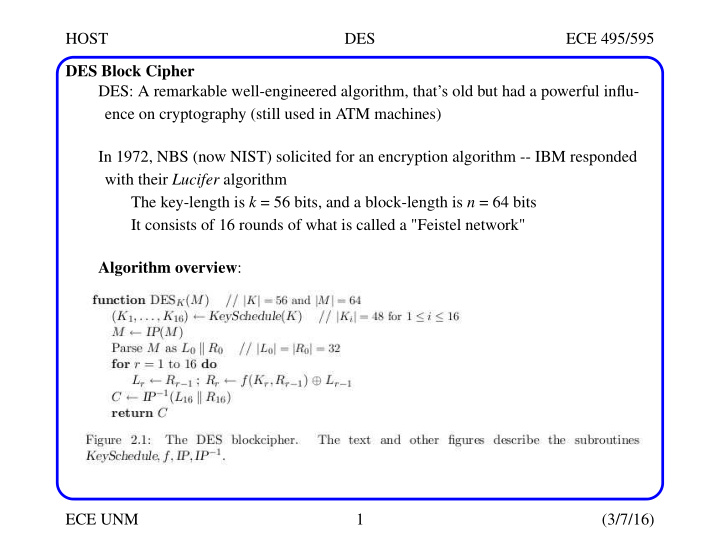



HOST DES ECE 495/595 DES Block Cipher DES: A remarkable well-engineered algorithm, that’s old but had a powerful influ- ence on cryptography (still used in ATM machines) In 1972, NBS (now NIST) solicited for an encryption algorithm -- IBM responded with their Lucifer algorithm The key-length is k = 56 bits, and a block-length is n = 64 bits It consists of 16 rounds of what is called a "Feistel network" Algorithm overview : ECE UNM 1 (3/7/16)
HOST DES ECE 495/595 DES Block Cipher The KeySchedule produces from the 56-bit key K (as input), a sequence of 16 subkeys (each 48-bits long), one for each of the rounds that follow The initial permutation IP simply permutes the bits of M as given in the following table. Here, the table indicates that bit 1 of the output is bit 58 of the input, bit 2 is bit 50 , ..., bit 64 is bit 7 of the input The key is NOT involved in this permutation and therefore, this permutation does not appear to affect the cryptographic strength of the algorithm The permuted plaintext now enters a loop, which iterates for 16 Feistel rounds ECE UNM 2 (3/7/16)
HOST DES ECE 495/595 Key Recovery Attacks on Blockciphers S-box functions are applied in these rounds, and are the heart of the algorithm S-boxes are functions taking 6 bits and returning 4 bits, and are basically a lookup-table One of the design goals of DES is speed, so all functions are easily mapped into hard- ware DES is impressively strong -- to this day, the best known attack is still exhaustive key search NO blockcipher is perfectly secure Best you can do is make exhaustive search computationally prohibitive But how long does the exhaustive search take? On average about 2 k-1 calculations of the blockcipher (worst case is of course 2 k ) (directly related to the key size) Consider DES: with 1.6 Gbit/sec and a plaintext length of 64 -bit, we can perform 2.5 * 10 7 DES computations/sec ECE UNM 3 (3/7/16)
HOST DES ECE 495/595 Key Recovery Attacks on Blockciphers To carry out 2 55 computations (with k = 56), we need 2 55 /(2.5 * 10 7 ) = 1.44 * 10 9 seconds or about 45.7 years! However, recently Electronic Frontier Foundation built a parallel machine for $250,000 that finds the key in 56 hours The main short-coming of DES was it key-length -- this prevented it from resisting exhaustive key searches. Proposed solutions Triple-DES + others ECE UNM 4 (3/7/16)
Recommend
More recommend